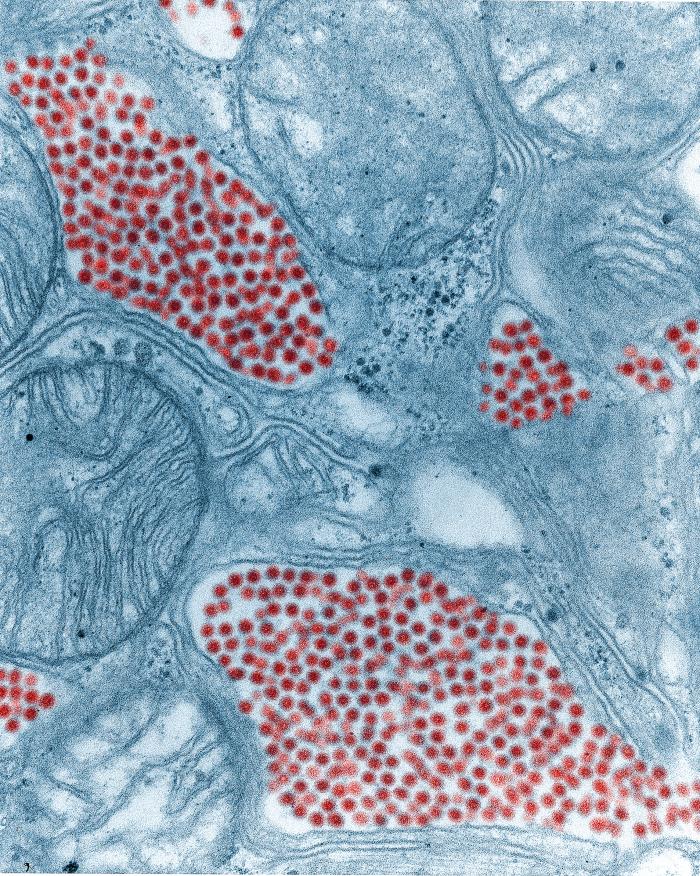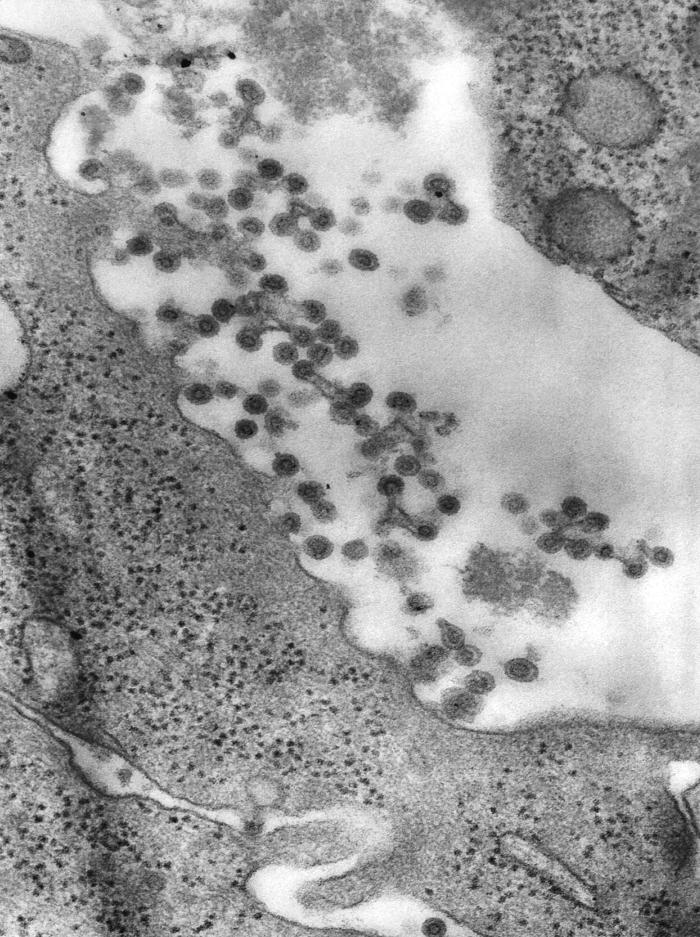Playlist
Show Playlist
Hide Playlist
Rubella and Other Togaviruses
-
02-42 Togaviruses.pdf
-
Download Lecture Overview
00:01 The togaviridae, viruses. 00:04 The togaviruses are small, enveloped, icosahedral capsules, such as you see in front of you on the electron microgram. 00:12 They have a linear, single-stranded, positive-sense RNA genome, and keep in mind that positive-sense RNA functions as messenger RNA in terms of its transcription. 00:23 There are several medically-relevant viruses we'll talk about under the togavirus heading. 00:29 One of those is the rubella virus, the cause of German measles. 00:33 But then the arboviruses, which are vector-associated, mosquito inserted viruses, are also important. 00:41 And these include several different encephalitis viruses known as the Eastern, the Western, and Venezuelan equine encephalitis virus, and a recent fame, chikungunya virus, which is emerging in significance as it comes across Central and South America. 00:57 Let's start with rubella virus. 01:00 This infection starts by acquisition into the upper respiratory tract, typically by a respiratory or a contact transmission, , and it sets up its primary or initial site of infection in lymph tissue, in local lymph nodes within the upper respiratory tract. 01:16 From there, comes the primary viremia, which then allows for a diffuse or disseminated skin rash as a localized immunologic reaction. 01:26 There is, then, also a prodromal period lasting for about 2 weeks, as the new virions, the new viruses are synthesized within their cellular target, and then released. 01:37 And during this time, the respiratory droplets are quite present and quite contagious. 01:43 So, the rashes first, but then it's followed by a highly contagious period, unlike some viruses which try to trick you by being highly contagious prior to the onset of the rash. 01:55 Transplacental infection and intrauterine exposure for congenital rubella is probably the biggest problem that we see with rubella virus because the German measles itself, as we'll see, is not that significant. 02:10 However, congenitally-acquired rubella because the virus can interfere with normal development of multiple fetal tissues with significant teratogenic effects. 02:23 What does the disease look like? Primary or, you know, typical rubella or German measles transmitted, again, by respiratory droplets has as its rash, a morbilliform rash, which simply means measles-like It's not very helpful, unless you look at the picture in the upper right, and that displays discreet erythematous maculopapular lesions, which are a darker pink than perhaps a lighter salmon-colored or an allergic rash. 02:53 The rash, as it does with other viruses, especially measles, begins at the cranial region, begins at the head, and then it moves slowly on down toward the caudal region. 03:05 As it does so, a one -- the patient develops a post- auricular, so a post-cervical lymphadenopathy. 03:13 Most children who suffer from German measles aren't stopped by this at all. 03:17 They're out playing, having fun, exposing everybody else to their lovely rubella virus. 03:23 Adults, however, will many times develop a diffuse polyarthralgia, bordering on arthritis by the severity of the pain. 03:30 And they also may progress to a thrombocytopenia or a postinfectious encephalitis. 03:36 Prevention for this is accomplished through the measles mumps rubella shot, the MMR, which is provided to children beginning at 12-15 months of life, followed by a booster at age 4-5. 03:48 That is a live attenuated vaccine, and in terms of rubella, it has been highly successful in preventing cases. 03:56 Those patients or those mothers who had not been immunized to rubella and develop acute rubella during their pregnancy are able to transmit the virus to their fetus, to their baby. 04:09 And especially if that infection occurs, and transfer occurs prior to the 20th week of gestation, the baby will demonstrate some very significant effects. 04:18 In the lower right picture, you see a baby with bilateral cataracts, with the white cataract material seen within the iris. 04:28 That is a very common expression or manifestation of congenital rubella. 04:33 So, too, would be cognitive to delay, a mental retardation and sensory neural deafness like many other congenitally-acquired viral infections, like cytomegalovirus. 04:44 The blueberry muffin spot is a site of extramedullary hematopoiesis, which is seen in the skin and these lesions are somewhat raised. 04:55 They are dark red bordering on purple, and they indeed are where extra hematopoiesis, extra erythrocyte derivation is occurring outside of the bone marrow because these patients are typically anemic. 05:08 Yeah. 05:08 In addition to those findings, central core cardiac abnormalities may occur, including a patent ductus arteriosus, and even coarctation of the aorta So, this is a very significant process. 05:23 Children born with congenital rubella have multiple challenges facing them throughout the rest of their life. 05:30 This slide demonstrates an infant picture on the right with blueberry muffin or blueberry skin lesions, which you see there is dark purplish violations, mackerels and or nodules. 05:41 And this again is due to extra medullary hematopoietic is in the dermis. 05:45 In this case, secondary to congenital rubella, the most common cause of blueberry skin lesions. However, there are other causes of blueberry skin lesions due to that extra medullary metabolizes, and those include congenital viral infections, especially cytomegalovirus and occasionally actually toxoplasmosis, not a virus, but an additional torch infection. 06:06 But there are also certain hematologic disorders, such as any hemolytic disease of the newborn, which can precipitate development of that extramedullary hematopolesis There are other, of course, violations, neonatal skin lesions not due to extra hemodialysis. 06:23 And these can be caused by infiltration of the skin by leukemic cells such as an infant with acute myeloid leukemia or metastatic lesions such as due to neuroblastoma, and then certain congenital vascular disorders, such as multiple hematomas of infancy. 06:43 Let's turn now to diseases caused by the arboviruses, and we'll start with Eastern equine encephalitis. 06:49 Keep in mind that all these are transferred by the bite of an infected mosquito, Eastern equine virus, or Eastern equine encephalitis by the Eastern equine encephalitis virus starts with fever and headache, along with vomiting, and progresses rapidly to include elevated white blood cells and dizziness. 07:10 As the patients go further into the immunologic response to the virus, they'll develop decreasing levels of consciousness, accompanied by seizures and focal neurological signs. 07:20 Patients who survive this, and most do, but they're left with chronic convulsions, chronic epilepsy, as well as sometimes focal paralysis and absolutely significant challenges with cognition. 07:37 The Western equine encephalitis virus causes Western equine encephalitis, and here, most patients start off either with an asymptomatic prodrome or at the very worst, a mild, flu-like illness, so they may develop this altered mental status out of the blue. 07:54 Many times, toward the end of the summer after mosquito bites may have occurred, they'll develop this change in consciousness. 07:58 They'll become weak. 07:59 They may develop some neck pain, neck stiffness because of meningeal irritation, photo phobia. 08:05 Frequently, these patients come to medical attention with a concern for some form of meningitis, but they then keep progressing into somnolence, to coma. 08:15 Here, when the patients wake up, and they may have required extended medical care to do so, they may be left with cognitive delay, emotional instability, and spastic paresis causing contractures. 08:30 Venezuelan equine encephalitis. 08:32 So here again, starting with flu-like symptoms, developing retro-orbital or occipital headaches, leucopenia, tachycardia, mostly a very severe flu-like illness, but then they also progress into somnolence, coma, seizures, confusion, photo phobia, the whole 9 yards. 08:51 You see a recurring theme here, starting off flu-like, progressing into aseptic meningitis-like symptoms, and then into coma. 08:59 And then long-term effects in Venezuelan equine encephalitis will be focal neurological damage, causing some paresis, focal neurological damage, causing some paresis, That may occur in others of the encephalitis viruses we've just talked about, but the numbers have been so low that they've been poorly described. 09:20 However, in Venezuela, in which surprise, surprise, most of our information comes from, there were a larger number of people including pregnant mothers, and so we have some information about perinatal acquisition of the disease. 09:35 And then chikungunya. 09:37 This also is carried by the bite, in this case, of the Aedes mosquito and these patients start off with the high fevers. 09:46 The joint pain, though, and the rash, which is another macular rash, are quite peripheral. 09:52 In fact, if you look at pictures or even see a patient with chikungunya, they frequently are unable to walk because the peripheral pain, the ankles, the feet, the wrists, is incredibly severe. 10:04 And unfortunately, there's a chronic form, as you see there, in which the pain keeps coming back for months upon months. 10:12 Along with the severe peripheral arthralgia and arthritis, these patients also may have conjunctivitis, headache, fatigue, etc. 10:21 Chikungunya is actually a Swahili term which in very rough translation means that which bends up, which is a reference to just how severely inflamed those joints are, and just how painful the patients feel when trying to walk. 10:38 So, we have here a collection of viruses all which seem to have either central nervous system or the rubella, the focus on rash and a congenital or intrauterine transmission. 10:52 But overall, these are very serious group of viruses that can be transmitted very much un- suspiciously and without prior warning. 11:01 So, the only recommendation I have to you now is put on your mosquito spray when you go outside.
About the Lecture
The lecture Rubella and Other Togaviruses by Sean Elliott, MD is from the course Viruses.
Included Quiz Questions
Which of the following lymph nodes are typically involved in the clinical course of German measles?
- Postauricular
- Preauricular
- Submental
- Submandibular
- Jugulodigastric
The type of vaccine used for the prevention of rubella infection is...?
- ...live attenuated.
- ...whole-cell inactivated.
- ...toxoid.
- ...recombinant.
- ...subunit.
Which of the following congenital heart diseases is most frequently associated with the transplacental transmission of rubella infection of the fetus?
- Patent ductus arteriosus
- Ventricular septal defect
- Atrial septal defect
- Tetralogy of Fallot
- Transposition of great arteries
Most frequently encountered complication of infection by the chikungunya virus is which of the following?
- Chronic arthralgia
- Birth defects
- Seizures
- Mental retardation
- Paralysis
Which of the following correctly describes the genome of the eastern equine encephalitis virus?
- Linear, single-stranded RNA
- Linear, double-stranded DNA
- Circular, single-stranded RNA
- Circular, single-stranded DNA
- Circular, double-stranded DNA
Customer reviews
4,0 of 5 stars
| 5 Stars |
|
0 |
| 4 Stars |
|
1 |
| 3 Stars |
|
0 |
| 2 Stars |
|
0 |
| 1 Star |
|
0 |
I chose this because I am a fan of viruses and I want to invent a Medicine for all viruses and I loved it very much because I want to help mankind and learn, and this is a type that we must all talk about.





